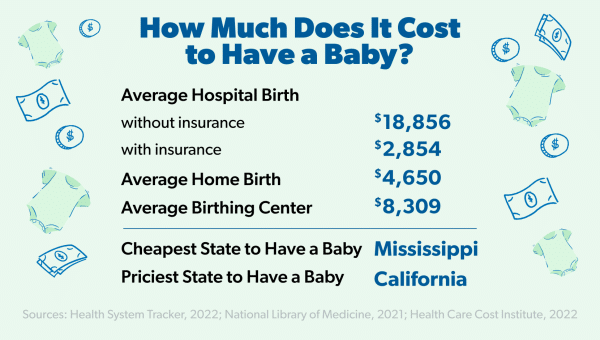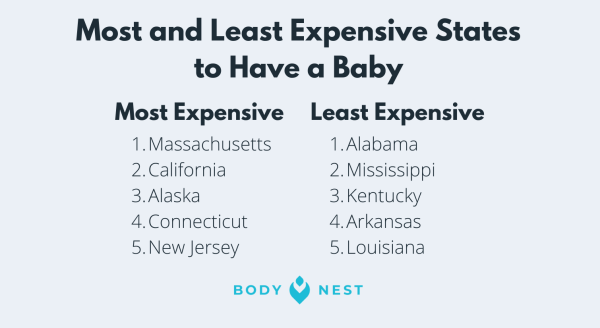Are you ready for the most exciting journey of your life? A journey filled with laughter, tears, and countless memorable moments? We are here to answer the burning question on every prospective parent’s mind: what is the cheapest way to have a baby? In this article, we will explore various options and strategies that can help you navigate the financial aspect of starting a family, ensuring that the joy of bringing a new life into the world doesn’t come with an overwhelming price tag. So, buckle up and get ready to discover how to make your dream of parenthood a reality without breaking the bank!
This image is the property of cdn.ramseysolutions.net.
Review contents
Hospital Delivery
Choosing a Public Hospital
When choosing a hospital for your delivery, opting for a public hospital can be cost-effective. Public hospitals typically have lower fees than private hospitals, making them a more affordable choice for many families. These hospitals are often funded by the government and offer quality care while keeping costs minimal. Public hospitals usually have well-trained medical staff and a wide range of resources to cater to the needs of expectant mothers and their babies.
Choosing a Private Hospital
While public hospitals may offer affordability, private hospitals provide different advantages for those who can afford them. Private hospitals generally offer personalized care and amenities, such as private rooms and better accommodations for partners or support persons during delivery. However, it is essential to note that private hospitals often incur higher costs. As a result, they may not be the most budget-friendly option for everyone, especially if insurance coverage is limited.
Insurance Coverage
Insurance coverage is a crucial aspect to consider when planning for a hospital delivery. A comprehensive insurance plan can significantly reduce out-of-pocket expenses associated with labor and delivery. Reviewing your insurance policy and understanding what is covered, including prenatal visits, hospital stays, and postpartum care, is essential. Another factor to consider is whether the hospital you choose is within your insurance provider’s network. This can help avoid unexpected expenses and ensure you receive maximum coverage.
Negotiating the Price
If you face significant medical bills after your hospital delivery, do not hesitate to negotiate the price. Many hospitals will work with patients to find a reasonable payment plan or reduce the overall cost. It is crucial to communicate your financial situation honestly and seek assistance from the hospital’s financial department. They may be able to provide options such as discounts, payment plans, or financial assistance programs to help ease the financial burden and make the cost of childbirth more manageable.
Birth Centers
Low-Cost Alternatives
Birth centers offer an alternative option for those seeking a lower-cost childbirth experience. These centers are often staffed by certified nurse-midwives who prioritize a more holistic approach to childbirth. Birth centers are designed to create a home-like environment, offering a more personal and intimate setting for labor and delivery. Additionally, birth centers tend to have lower overhead costs than hospitals, translating to lower fees for expectant parents.
Insurance Coverage
When considering a birth center, it is crucial to check your insurance coverage. While some insurance plans may cover birth center births, others may not provide the same level of coverage as they would for hospital delivery. Contact your insurance provider to inquire about the extent of coverage for birth center services. Understanding your insurance benefits will help you plan financially and prevent unexpected costs.
Home Birth
Cost Considerations
A home birth can be an option for those seeking a more intimate and familiar environment. Home births are often more cost-effective than hospital or birth center deliveries. However, it is essential to consider the potential costs associated with home births. These may include fees for certified professional midwives, necessary supplies and equipment, and occasional additional services such as ultrasound scans or blood tests. Discussing these expenses with your midwife and creating a comprehensive budget to ensure financial preparedness is essential.
Insurance Coverage
Insurance plans may not always cover home births, making it necessary to review your policy. While some insurance providers may offer partial or complete coverage for home births, others may consider them out-of-network or elective procedures and provide limited coverage. Reach out to your insurance provider to understand the extent of coverage for planned home births and explore any available options for financial assistance.
Safety and Legal Concerns
Safety is a primary concern when considering a home birth. It is crucial to consult with a certified professional midwife who is experienced in home births and can provide personalized guidance based on your medical history and risk factors. Additionally, familiarize yourself with the legal regulations surrounding home births in your area. Ensure that you comply with all requirements and have a backup plan in case of emergencies or the need to transfer to a hospital.
Midwife-led Care
Low-Cost options
Midwife-led care can be more affordable than traditional medical care during pregnancy and childbirth. Midwives provide comprehensive prenatal care, labor support, and postpartum care while focusing on a more individualized and natural approach. Midwives often offer services at a lower cost than the fees associated with obstetricians and gynecologists. This makes midwife-led care viable for families seeking a more affordable pregnancy and birthing experience.
This image is the property of www.livingwellspendingless.com.
Government Assistance Programs
Medicaid
Medicaid is a government assistance program designed to provide healthcare coverage to low-income individuals and families. Pregnant women often qualify for Medicaid based on income and other eligibility criteria. This program covers various aspects of prenatal care, labor and delivery, and postpartum care, ensuring that expectant mothers can access essential medical services without incurring substantial costs. Applying for Medicaid early in your pregnancy is crucial to confirm eligibility and secure comprehensive coverage throughout your pregnancy and birth process.
Children’s Health Insurance Program (CHIP)
The Children’s Health Insurance Program (CHIP) is another government assistance program that helps provide healthcare coverage to children from low-income families who do not qualify for Medicaid. CHIP offers comprehensive health benefits, including prenatal care, labor and delivery, and postpartum care. If you are pregnant and currently uninsured, exploring CHIP can provide valuable assistance in covering the medical costs associated with pregnancy, childbirth, and the health of your child.
Women, Infants, and Children (WIC) Program
The Women, Infants, and Children (WIC) program provides nutrition assistance to low-income pregnant women, new mothers, and young children. This program offers support through nutritious food options, breastfeeding guidance, and access to healthcare services. Participating in the WIC program can alleviate some financial burdens associated with obtaining a healthy diet during pregnancy and the early years of your child’s life.
Prenatal Care
Choosing a low-cost clinic
Finding an affordable prenatal care provider is essential to ensure your and your baby’s health and well-being. Numerous low-cost clinics and community health centers offer comprehensive prenatal care at reduced costs or on a sliding fee scale based on income. These clinics often provide various services, including prenatal check-ups, ultrasounds, blood tests, and nutritional guidance. Researching and contacting these clinics in your area will help you find quality prenatal care that fits within your budget.
Applying for Medicaid
Applying for Medicaid is a vital step in accessing low-cost prenatal care. As mentioned, Medicaid provides comprehensive coverage for pregnant women, including prenatal visits, laboratory tests, and ultrasounds. The application process typically involves providing necessary documentation, such as proof of income, residency, and pregnancy. Applying early in your pregnancy ensures that you receive timely and consistent prenatal care while minimizing out-of-pocket expenses.
Community health centers
Community health centers aim to provide affordable healthcare services to underserved populations. These centers offer various medical and prenatal care services, including prenatal check-ups, screenings, and referrals. They cater to individuals and families with limited income and those without insurance. By seeking care at a community health center, you can receive high-quality prenatal care at a reduced cost or on a sliding fee scale.
Local health departments
Local health departments are an excellent resource for accessing low-cost prenatal care services. They often offer programs tailored to low-income individuals and families, ensuring that expectant mothers receive adequate prenatal care despite financial constraints. Contacting your local health department can help you navigate available services and programs in your community.
This image is the property of www.bodynestofficial.com.
Supplemental Nutrition Assistance Program (SNAP)
Enhancing Access to Nutritious Food for Pregnant Women
The Supplemental Nutrition Assistance Program (SNAP), formerly Food Stamps, is a federal assistance program that provides eligible individuals and families access to nutritious food. Pregnant women, especially those with low income, can benefit from SNLAP to ensure they receive essential nutrients for a healthy pregnancy. By participating in SNAP, you can receive an Electronic Benefits Transfer (EBT) card, which can be used to purchase approved food items at authorized retailers. This assistance program can significantly support your nutritional needs while managing the cost of groceries during pregnancy.
Childbirth Classes
Choose Affordable Classes
Childbirth classes are an excellent way to gain knowledge and prepare for the upcoming birth of your baby. These classes include childbirth techniques, relaxation and breathing exercises, pain management options, and newborn care. However, some childbirth classes can be costly, adding to the financial strain of pregnancy and childbirth. To find affordable classes, consider seeking community-based or non-profit organizations offering reduced-cost or sliding-scale fee options. These classes can still provide valuable information and support without breaking the bank.
Look for Free or Low-Cost Options
In addition to affordable classes, free or low-cost childbirth education resources can be found online or at local libraries. Many organizations offer downloadable materials, instructional videos, and even virtual classes free of charge. Utilizing these resources can help you gain the knowledge and confidence needed during pregnancy and childbirth without incurring additional expenses.
This image is the property of images.saymedia-content.com.
Baby Essentials
Choosing Affordable Baby Items
Preparing for your baby’s arrival can be exciting but also financially challenging. To reduce expenses, opt for affordable baby essentials. Compare prices from different stores, research online marketplaces for budget-friendly options, and consider purchasing items secondhand. Many baby essentials, such as cribs, strollers, and clothing, can be found in excellent condition at a fraction of the original cost. Prioritize the safety and functionality of the items you choose, and remember that being expensive does not always equate to better quality.
Accepting Hand-Me-Downs and Secondhand Items
Accepting hand-me-downs and secondhand items from family, friends, or local community groups can be an excellent way to save money on baby essentials. Babies proliferate and outgrow their clothes and gear in no time. Accepting gently used items from trusted sources helps reduce costs and promotes sustainability by giving these items a new life instead of ending up in landfills. Ensure that secondhand items meet safety standards and are thoroughly cleaned before use.
Breastfeeding
Free Natural Option
Breastfeeding is a natural and cost-effective way to nourish your baby. Not only does breast milk provide optimal nutrition for infants, but it also has numerous health benefits for both mother and child. By choosing to breastfeed, you can eliminate the need for expensive formula and feeding supplies, ultimately reducing your overall baby-related expenses. Breastfeeding promotes bonding and provides emotional comfort for the baby and the mother.
Access to Lactation Support
To ensure a successful breastfeeding journey, access to lactation support is crucial. Many hospitals, birth centers, and community organizations offer free or low-cost lactation consultations, support groups, and breastfeeding classes. These resources can provide guidance, address any challenges or concerns, and offer valuable tips to promote successful breastfeeding. These services can help foster a positive breastfeeding experience and mitigate the need for costly interventions or formula feeding.
In conclusion, there are various ways to have a baby while keeping costs minimal. From exploring affordable hospital options to considering midwife-led care, government assistance programs, low-cost prenatal care, and budget-friendly resources for baby essentials, there are plenty of opportunities to navigate pregnancy and childbirth without breaking the bank. By being proactive, informed, and resourceful, you can make decisions that align with your financial situation while ensuring your and your baby’s health and well-being.
This image is the property of cdn.vox-cdn.com.



































